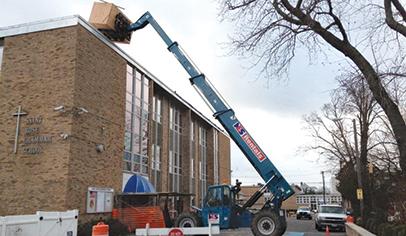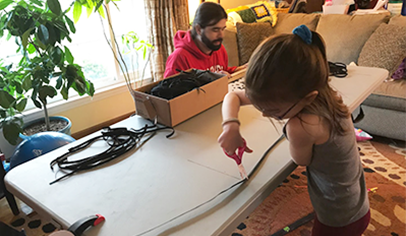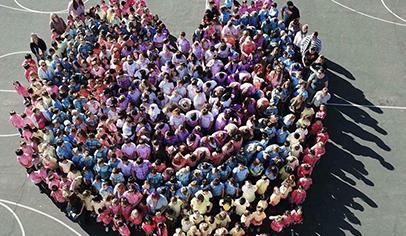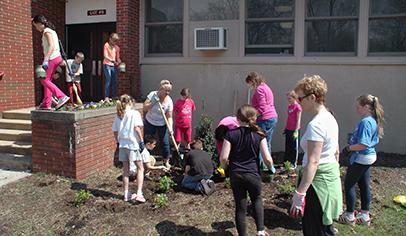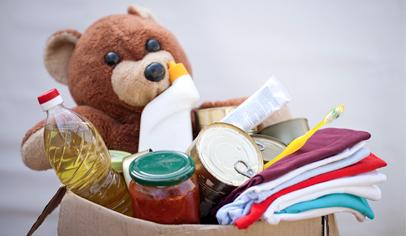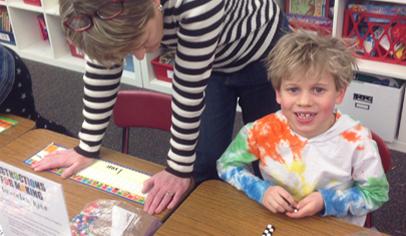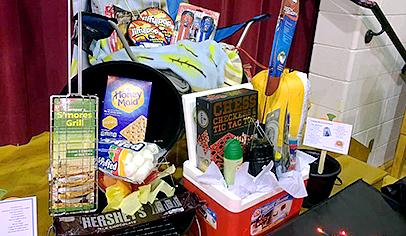It started with a simple question: What can we do? And in the days following Hurricane Sandy, one of the most devastating storms ever to hit the New York and New Jersey area, that one question set off a chain reaction of parent groups and volunteers helping their schools, their families, and other school communities.
In the face of what will no doubt be a multi-year rebuilding process from the October 2012 storm involving government bureaucracies, insurance claims, and plenty of politics, the efforts of parent volunteers underscore the importance of simple, straightforward actions in a time of need.
With a series of phone calls and a meeting over coffee, Sue Dandaraw, a parent volunteer at South Row Elementary in Chelmsford, Mass., helped organize a donation drive that benefited four schools on Staten Island, N.Y. “I didn’t come up with some amazingly brilliant fundraising idea,” she says. “I just facilitated what people wanted to do.”
Dandaraw’s story is one of many that shows how such basic steps as sending out a call for help on Facebook or cold-calling schools to offer assistance can go far in getting a community back on its feet.
Pennies and Pencils
While Homeira Walter, president of the PTO at Monmouth Beach (N.J.) School, waited out Hurricane Sandy in a neighboring town, she received a text message from the superintendent saying the school was sitting in 3 feet of water.
Damage to the school, adjacent to both the Atlantic Ocean and the Shrewsbury River, was so extensive that it was shut down and its students, from prekindergarten through 8th grade, were sent to three different schools in Monmouth.
Overnight, Walter’s fairly routine role of PTO president became more akin to that of a disaster relief manager as she acted as a point person, helping those who wanted to help the school. She designated her home address for the delivery of all school donations and worked closely with the superintendent to use donated funds to get immediately needed supplies like textbooks.
Walter says the enormity of the hurricane damage didn’t sink in until she logged on to Facebook and saw a message from a former student asking, “Is there any way we can help?”
The PTO president put this now-grown student in touch with a teacher, and together they created a school supplies list that they posted on an Amazon.com personal account. Then Walter heard from a friend whose cousin, a teacher at Regnart Elementary in Cupertino, Calif., wanted to help Monmouth Beach School. Walter and the West Coast teacher communicated on Facebook, and soon the teacher was posting photos of a penny drive that her students were doing to help
the New Jersey school.
Once word of the efforts got out on Facebook, other schools reached out to Walter. Altogether, schools in some 30 communities sent donations in the first few months after the storm for either the school or its families. Johnson Elementary in Natick, Mass., held a penny collection and a pancake breakfast. A teacher documented the effort and created a video called “We Take Care of Each Other,” now on YouTube, about Johnson’s fundraising efforts to donate more than $2,500 to Monmouth Beach.
With the incredible volume of donations arriving at Monmouth Beach, the PTO realized it actually had more school supplies than it needed—it received more than $40,000 in school supplies from the Amazon.com drive and an additional $58,000 in cash, gift cards, and personal items from schools and individuals.
So when a teacher heard that a school in nearby Keansburg, N.J., needed help, Walter packaged up extra supplies and the teacher delivered them.
Monmouth Beach administrators hope the students are back at the school by June so the 8th grade class can graduate from that building. More likely, it will reopen in September.
Staten Island Road Trip
Sue Dandaraw, who grew up on Staten Island, traveled there in early November with her brother to check on her parents. She also took a van full of items donated by the community.
When Cathy Poisson, a PTO vice president at South Row Elementary in Massachusetts, heard about Dandaraw’s trip to Staten Island to deliver basic necessities, she said, “I want to do that!”
When Dandaraw returned, Poisson invited her to an upcoming PTO morning coffee. Once Dandaraw shared stories of her New York visit, describing the piles of rubble on the roads and the shocked, silent people (“There was no screaming, no chaos,” says Dandaraw. “Just quiet.”), the PTO decided it wanted to work with her and together send more aid.
“That’s where the idea of schools helping schools came about,” Dandaraw says.
At first, Poisson and Dandaraw had no idea what the next step should be. So they got together one evening, along with Dafna Erickson, another PTO vice president, and pulled up a map of Staten Island online. Dandaraw zeroed in on the neighborhoods that she had seen on her first visit. “I knew these were [some of] the most devastated,” she says.
They then selected names of several schools in that area. The next day, Dandaraw started cold-calling the schools. After many phone calls to track people down, Dandaraw confirmed that the South Row PTO would send donations to three elementary schools (P.S. 038 George Cromwell, P.S. 039 Francis J. Murphy Jr., and P.S. 052 John C. Thompson) and one intermediate school (I.S. R002 George L. Egbert). Two of the elementary schools requested gift cards that they could distribute to families. One wanted board games to give out at a holiday event. The intermediate school requested gift cards and had a wish list from families who needed basic supplies for their homes.
Meanwhile, Poisson worked on the Chelmsford end. After getting approval from both her principal and superintendent to run a systemwide donation drive, she reached out to all the PTO leaders in town. They were happy to team up with South Row. Every few days, Poisson or Dandaraw would swing by the schools and pick up donated gift cards. South Row collected board games and handled the family wish list collections.
The week before Christmas, Poisson, Dandaraw, and one of Dandaraw’s friends wrapped the board games and the wish list items. Then they loaded up Dandaraw’s 10-year-old minivan with the wrapped gifts and $7,000 in gift cards, and Dandaraw and her friend headed south.
When they arrived on Staten Island, they delivered the wrapped gifts and cards to the schools and some individual families. By the end of the day, Dandaraw and her friend were exhausted. A car had actually hit Dandaraw’s minivan while she was driving earlier, leaving a dent. Now it was dark and she was ready to get home. They approached the very last stop on the route and ended up getting a badly needed boost. The woman who answered the door was so grateful, all she could say was, “You can’t be real!”
Giving and Receiving
Parents at Saint Rose Grammar School in Belmar, N.J., another coastal town, had been preparing for an upcoming fundraiser when they heard Hurricane Sandy was approaching. Some members went to the convent on the Saint Rose campus where their gift auction baskets and prizes were lined up. They made sure everything was placed on tables so nothing would get damp. They thought they had it covered.
But when Hurricane Sandy departed, so too did the baskets and prizes. Some buildings on the school campus, including a high school, took in several feet of water. The high school’s cafeteria had about 800 pounds of fish from the Atlantic strewn about. Part of the roof was missing from the grammar school building. Five sea turtles were found wandering in the parking lot and were returned to the ocean.
As disappointing as the lost baskets were, this PTA had bigger worries. The Saint Rose families and members of the surrounding community came first. “What we did initially was to assess how our families were doing,” says Loretta Cedrone, PTA president. “Some of our families lost their homes, a basement, a first floor. Some had lost their vehicles. There were real immediate needs.”
A Saint Rose building called the Annex had no damage, so that became a relief center that was quickly stocked with diapers, blankets, clothes, and other basics by community members. Their generosity was overwhelming, says principal Bill Roberts. Without prompting, parents and other community members showed up to help. “One day, there were 20 or 30 people from our school helping organize and guide people through [the relief center], helping them get provisions to their cars,” Roberts says. Other parents volunteered to deliver supplies to families who no longer had transportation.
It seemed at times that as many people were giving as were receiving. “When I drove into Belmar one morning, there was a line of people waiting to drop off donations,” says Kristi Gorman, publicity chair of the PTA. “It was incredibly touching.”
Meanwhile, the PTA decided it wanted to go forward with its fundraiser, in part to boost morale. It rescheduled the event, but it had no money to recreate its gift auction baskets and didn’t want to rely on its families to help out. So it sent out a distress call on the PTO Today Facebook page and within hours started getting messages of encouragement and promises of donations from all over the country to help make new gift auction baskets.
Because of that Facebook call for help as well as families telling other families of the disaster, news of the storm damage at Saint Rose spread. A dozen schools from across the country have reached out to provide assistance to families and the school with gift cards, books, and money. Some of the funds were used to buy necessities and, in some cases, to assist with tuition while families get back on their feet, Roberts says.
Cedrone says she is also moved by how generous people are. For example, she knows of one volunteer who was working with contractors to rebuild her destroyed home while she and her family live in temporary housing. Yet the woman showed up at the school on a regular basis to help the PTA assemble new baskets for the rescheduled auction.
Large-scale disasters like Hurricane Sandy can make the day-to-day tasks of parent groups seem insignificant. But it’s the sense of community PTOs and PTAs build all year long through family events that makes them uniquely equipped to respond when the unexpected happens. As these stories show, parent groups can play an important role in helping things get back to normal after a disaster strikes. And for these groups, it all started by asking the simple question: What can we do?
Making Connections
In the wake of a disaster as big as Hurricane Sandy, parents often want to help but are uncertain of where to begin. Veteran volunteers suggest one step at a time and offer these tips:
Find a personal connection. Ask board members, teachers, and other parents if they know of anyone who may have a direct tie to a school that needs help.
Check in on social media. Many PTOs and PTAs use Facebook to update their communities; lots of initial information can be gathered from this social channel.
Be wary of unfamiliar online disaster relief organizations. Sadly, con artists run online scams to take advantage of generous people, so make sure you get references if you want to use a middleman.
Call reputable sources for help. Contact local town officials, including the superintendent or mayor, as well as police and fire departments, to find out which schools need help or what local organizations you can work with.
Keep donations simple. Often, gift card or cash collections will work best. They allow recipients to get the items they need. Plus, gift cards are easy to get to schools or PTO leaders (via certified mail, for example).


